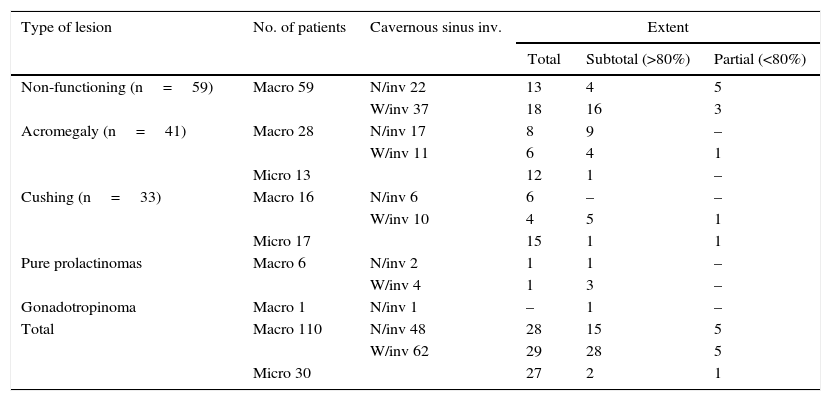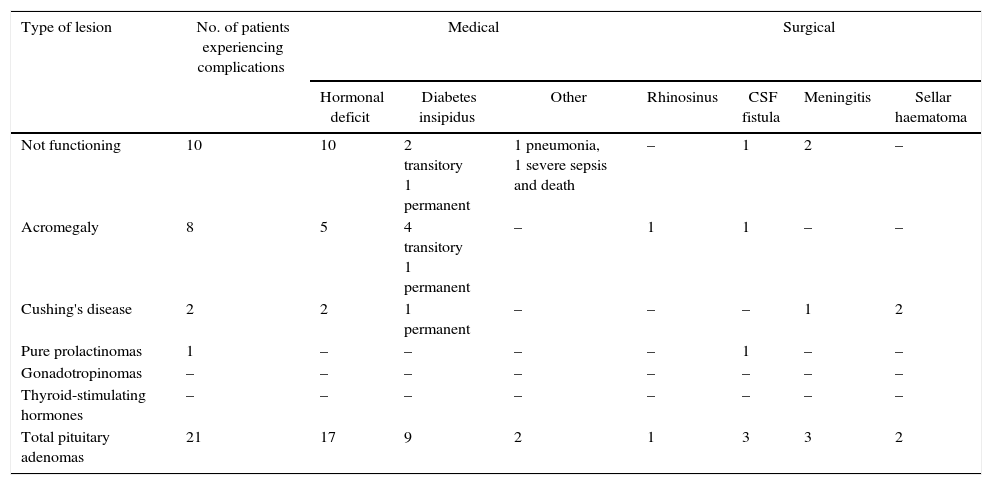To present the clinical and radiographic outcomes of 140 patients with pituitary adenomas treated by an endoscopic endonasal approach (EEA) over a period of 4 years.
Material and methodsA retrospective analysis was performed between 2011 and 2014. Pre and post operative MRI, ophtalmological assessment, endocrinological laboratory evaluation and surgical morbidity and mortality were assessed.
Results57.9% of the patients had functional tumours (n=81), acromegaly being the most frequent sub-type (29.3%). 78.6% of the lesions were macroadenomas (n=110) of which 56.4% (n=62) involved the cavernous sinus, 61 patients presented with visual field defects (44%) of which 50.8% of patients showed improvement after surgery. Gross total removal was achieved in 60% of the cases. Hormonal remission was achieved in the 75% of the patients with functional tumours. The morbidity rate was 15% and one patient died after surgery (mortality 0.7%).
ConclusionEEA is a safe and effective tool to treat pituitary adenomas. The main limitation for complete surgical resection is the cavernous sinus invasion.
Presentar los resultados y las complicaciones de 140 pacientes con adenomas hipofisarios operados por vía transnasal endoscópica en un período de 4 años.
Material y métodosSe realizó un análisis retrospectivo desde marzo del 2011 hasta diciembre del 2014. Se analizaron las imágenes, los estudios oftalmológicos y hormonales, tanto pre como postoperatorios, así como también la morbimortalidad asociada al procedimiento quirúrgico.
ResultadosSe registró un 57,9% de pacientes con tumores funcionantes (n=81), siendo la patología más frecuente la acromegalia (29,3%). El 78,6% fueron macroadenomas (n=110), de los cuales el 56,4% (n=62) presentaban invasión del seno cavernoso; 61 presentaron alteración en el campo visual computarizado (44%). Tras la intervención, el 50,8% de los pacientes obtuvo mejoría. En un 60% de los casos se alcanzó una resección completa. De los pacientes con patología funcionante (81 casos), un 25% persistió con enfermedad activa tras la cirugía. Se registró un 15% de pacientes complicados (n=21) y un solo fallecimiento (0,7%).
ConclusiónSegún los resultados obtenidos, esta técnica presenta baja morbimortalidad y elevado éxito terapéutico. La principal limitante para la resección quirúrgica completa es la invasión del seno cavernoso.
Article

If it is the first time you have accessed you can obtain your credentials by contacting Elsevier Spain in suscripciones@elsevier.com or by calling our Customer Service at902 88 87 40 if you are calling from Spain or at +34 932 418 800 (from 9 to 18h., GMT + 1) if you are calling outside of Spain.
If you already have your login data, please click here .
If you have forgotten your password you can you can recover it by clicking here and selecting the option ¿I have forgotten my password¿.













